Computational Designed and Optimized Liposomal Curcumin-Embedded Bifunctional Cross-Linked Hydrogels for Wound Healing
Abstract
1. Introduction
2. Results and Discussion
2.1. Preparation and Optimization of Curcumin-Loaded Liposomes by DoE
2.2. Differential Scanning Calorimetry
2.3. Antioxidant Activity
2.4. Cytotoxicity Assessment
2.5. Preparation and Optimization of Hydrogel by DoE
2.6. Addition of the Synthesized PNVP-ITA to the Hydrogel
2.7. Drug Loading and In Vitro Drug Release Study
2.8. In Vivo Skin Recovery Study
3. Conclusions
4. Materials and Methods
4.1. Materials
4.2. Preparation and Optimization of Curcumin-Loaded Liposomes by DoE
4.3. Characterizations of Curcumin-Loaded Liposomes
4.3.1. Particle Size, PDI, and ZP
4.3.2. Drug Determination
4.4. Differential Scanning Calorimetry
4.5. Antioxidant Activity
4.6. Cytotoxicity Assessment
4.7. Synthesis of Poly(N-Vinylpyrrolidone-Co-Itaconic Acid)
4.8. Preparation and Optimization of Hydrogel by DoE
4.9. Characterizations of HA/PVA Hydrogels
4.9.1. Water Absorption
4.9.2. Erosion
4.9.3. Mechanical Properties
4.10. Preparation of Curcumin Liposome-Embedded Hydrogels
4.11. Morphology
4.12. In Vitro Drug Release Study
4.13. In Vivo Skin Recovery Study
4.14. Data Analysis
Supplementary Materials
Author Contributions
Funding
Institutional Review Board Statement
Informed Consent Statement
Data Availability Statement
Acknowledgments
Conflicts of Interest
References
- Las Heras, K.; Igartua, M.; Santos-Vizcaino, E.; Hernandez, R.M. Chronic wounds: Current status, available strategies and emerging therapeutic solutions. J. Control Release 2020, 328, 532–550. [Google Scholar] [CrossRef] [PubMed]
- Sen, C.K. Human Wound and Its Burden: Updated 2022 Compendium of Estimates. Adv. Wound Care 2023, 12, 657–670. [Google Scholar] [CrossRef] [PubMed]
- Boateng, J.S.; Matthews, K.H.; Stevens, H.N.; Eccleston, G.M. Wound healing dressings and drug delivery systems: A review. J. Pharm. Sci. 2008, 97, 2892–2923. [Google Scholar] [CrossRef] [PubMed]
- Kumar, A.; Jaiswal, M. Design and in vitro investigation of nanocomposite hydrogel based in situ spray dressing for chronic wounds and synthesis of silver nanoparticles using green chemistry. J. Appl. Polym. Sci. 2015, 133, 43260. [Google Scholar] [CrossRef]
- Augustine, R.; Augustine, A.; Kalarikkal, N.; Thomas, S. Fabrication and characterization of biosilver nanoparticles loaded calcium pectinate nano-micro dual-porous antibacterial wound dressings. Prog. Biomater. 2016, 5, 223–235. [Google Scholar] [CrossRef]
- Aljghami, M.E.; Saboor, S.; Amini-Nik, S. Emerging Innovative Wound Dressings. Ann. Biomed. Eng. 2019, 47, 659–675. [Google Scholar] [CrossRef]
- Abruzzo, A.; Cappadone, C.; Sallustio, V.; Picone, G.; Rossi, M.; Nicoletta, F.P.; Luppi, B.; Bigucci, F.; Cerchiara, T. Development of Spanish Broom and Flax Dressings with Glycyrrhetinic Acid-Loaded Films for Wound Healing: Characterization and Evaluation of Biological Properties. Pharmaceutics 2021, 13, 1192. [Google Scholar] [CrossRef] [PubMed]
- Gefen, A.; Alves, P.; Beeckman, D.; Lazaro-Martinez, J.L.; Lev-Tov, H.; Najafi, B.; Swanson, T.; Woo, K. Mechanical and contact characteristics of foam materials within wound dressings: Theoretical and practical considerations in treatment. Int. Wound J. 2023, 20, 1960–1978. [Google Scholar] [CrossRef]
- Van Vlierberghe, S.; Dubruel, P.; Schacht, E. Biopolymer-based hydrogels as scaffolds for tissue engineering applications: A review. Biomacromolecules 2011, 12, 1387–1408. [Google Scholar] [CrossRef]
- Bilici, Ç.; Can, V.; Nöchel, U.; Behl, M.; Lendlein, A.; Okay, O. Melt-processable shape-memory hydrogels with self-healing ability of high mechanical strength. Macromolecules 2016, 49, 7442–7449. [Google Scholar] [CrossRef]
- Singh, B.; Sharma, S.; Dhiman, A. Design of antibiotic containing hydrogel wound dressings: Biomedical properties and histological study of wound healing. Int. J. Pharm. 2013, 457, 82–91. [Google Scholar] [CrossRef] [PubMed]
- Su, J.; Li, J.; Liang, J.; Zhang, K.; Li, J. Hydrogel preparation methods and biomaterials for wound dressing. Life 2021, 11, 1016. [Google Scholar] [CrossRef] [PubMed]
- Iranmanesh, P.; Ehsani, A.; Khademi, A.; Asefnejad, A.; Shahriari, S.; Soleimani, M.; Ghadiri Nejad, M.; Saber-Samandari, S.; Khandan, A. Application of 3D Bioprinters for Dental Pulp Regeneration and Tissue Engineering (Porous architecture). Transp. Porous Media 2022, 142, 265–293. [Google Scholar] [CrossRef]
- Chen, Y.; Li, J.; Lu, J.; Ding, M.; Chen, Y. Synthesis and properties of Poly(vinyl alcohol) hydrogels with high strength and toughness. Polym. Test. 2022, 108, 107516. [Google Scholar] [CrossRef]
- Chopra, H.; Bibi, S.; Kumar, S.; Khan, M.S.; Kumar, P.; Singh, I. Preparation and Evaluation of Chitosan/PVA Based Hydrogel Films Loaded with Honey for Wound Healing Application. Gels 2022, 8, 111. [Google Scholar] [CrossRef]
- Zhong, Y.; Lin, Q.; Yu, H.; Shao, L.; Cui, X.; Pang, Q.; Zhu, Y.; Hou, R. Construction methods and biomedical applications of PVA-based hydrogels. Front. Chem. 2024, 12, 1376799. [Google Scholar] [CrossRef]
- Wang, D.; Cui, F.; Xi, L.; Tan, X.; Li, J.; Li, T. Preparation of a multifunctional non-stick tamarind polysaccharide-polyvinyl alcohol hydrogel immobilized with a quorum quenching enzyme for maintaining fish freshness. Carbohydr. Polym. 2023, 302, 120382. [Google Scholar] [CrossRef]
- Li, M.; Chen, D.; Sun, X.; Xu, Z.; Yang, Y.; Song, Y.; Jiang, F. An environmentally tolerant, highly stable, cellulose nanofiber-reinforced, conductive hydrogel multifunctional sensor. Carbohydr. Polym. 2022, 284, 119199. [Google Scholar] [CrossRef]
- Liang, H.; Mirinejad, M.S.; Asefnejad, A.; Baharifar, H.; Li, X.; Saber-Samandari, S.; Toghraie, D.; Khandan, A. Fabrication of tragacanthin gum-carboxymethyl chitosan bio-nanocomposite wound dressing with silver-titanium nanoparticles using freeze-drying method. Mater. Chem. Phys. 2022, 279, 125770. [Google Scholar] [CrossRef]
- Li, L.; Zhang, Y.; Lu, H.; Wang, Y.; Xu, J.; Zhu, J.; Zhang, C.; Liu, T. Cryopolymerization enables anisotropic polyaniline hybrid hydrogels with superelasticity and highly deformation-tolerant electrochemical energy storage. Nat. Commun. 2020, 11, 62. [Google Scholar] [CrossRef]
- Liu, L.; Zhu, M.; Xu, X.; Li, X.; Ma, Z.; Jiang, Z.; Pich, A.; Wang, H.; Song, P. Dynamic Nanoconfinement Enabled Highly Stretchable and Supratough Polymeric Materials with Desirable Healability and Biocompatibility. Adv. Mater. 2021, 33, e2105829. [Google Scholar] [CrossRef]
- Luo, Z.; Wang, Y.; Li, J.; Wang, J.; Yu, Y.; Zhao, Y. Tailoring Hyaluronic Acid Hydrogels for Biomedical Applications. Adv. Funct. Mater. 2023, 33, 2306554. [Google Scholar] [CrossRef]
- Parhi, R. Cross-Linked Hydrogel for Pharmaceutical Applications: A Review. Adv. Pharm. Bull. 2017, 7, 515–530. [Google Scholar] [CrossRef]
- Xue, X.; Hu, Y.; Wang, S.; Chen, X.; Jiang, Y.; Su, J. Fabrication of physical and chemical crosslinked hydrogels for bone tissue engineering. Bioact. Mater. 2022, 12, 327–339. [Google Scholar] [CrossRef]
- Tabasi, H.; Babaei, M.; Abnous, K.; Taghdisi, S.M.; Saljooghi, A.S.; Ramezani, M.; Alibolandi, M. Metal–polymer-coordinated complexes as potential nanovehicles for drug delivery. J. Nanostructure Chem. 2021, 11, 501–526. [Google Scholar] [CrossRef]
- Liu, L.; Sun, L.; Wu, Q.; Guo, W.; Li, L.; Chen, Y.; Li, Y.; Gong, C.; Qian, Z.; Wei, Y. Curcumin loaded polymeric micelles inhibit breast tumor growth and spontaneous pulmonary metastasis. Int. J. Pharm. 2013, 443, 175–182. [Google Scholar] [CrossRef]
- Choudhary, V.; Shivakumar, H. A review on curcumin: Wound healing properties and biomarkers of wound healing. Int. Res. J. Pharm. 2018, 9, 1–5. [Google Scholar] [CrossRef]
- Barchitta, M.; Maugeri, A.; Favara, G.; Magnano San Lio, R.; Evola, G.; Agodi, A.; Basile, G. Nutrition and wound healing: An overview focusing on the beneficial effects of curcumin. Int. J. Mol. Sci. 2019, 20, 1119. [Google Scholar] [CrossRef]
- Akbik, D.; Ghadiri, M.; Chrzanowski, W.; Rohanizadeh, R. Curcumin as a wound healing agent. Life Sci. 2014, 116, 1–7. [Google Scholar] [CrossRef] [PubMed]
- Mohanty, C.; Sahoo, S.K. Curcumin and its topical formulations for wound healing applications. Drug Discov. Today 2017, 22, 1582–1592. [Google Scholar] [CrossRef] [PubMed]
- Verma, S.; Lan, Y.; Gokhale, R.; Burgess, D.J. Quality by design approach to understand the process of nanosuspension preparation. Int. J. Pharm. 2009, 377, 185–198. [Google Scholar] [CrossRef]
- Lee, M.K. Liposomes for Enhanced Bioavailability of Water-Insoluble Drugs: In Vivo Evidence and Recent Approaches. Pharmaceutics 2020, 12, 264. [Google Scholar] [CrossRef] [PubMed]
- Shin, G.H.; Chung, S.K.; Kim, J.T.; Joung, H.J.; Park, H.J. Preparation of chitosan-coated nanoliposomes for improving the mucoadhesive property of curcumin using the ethanol injection method. J. Agric. Food Chem. 2013, 61, 11119–11126. [Google Scholar] [CrossRef]
- Rao, S.; Song, Y.; Peddie, F.; Evans, A.M. Particle size reduction to the nanometer range: A promising approach to improve buccal absorption of poorly water-soluble drugs. Int. J. Nanomed. 2011, 6, 1245–1251. [Google Scholar] [CrossRef]
- Kanicky, J.R.; Shah, D.O. Effect of degree, type, and position of unsaturation on the pKa of long-chain fatty acids. J. Colloid. Interface Sci. 2002, 256, 201–207. [Google Scholar] [CrossRef]
- Shaker, S.; Gardouh, A.R.; Ghorab, M.M. Factors affecting liposomes particle size prepared by ethanol injection method. Res. Pharm. Sci. 2017, 12, 346–352. [Google Scholar] [CrossRef]
- Wang, D.K.; Zhang, C.X.; Zhang, W.T.; Zhao, C.H.; Guan, S.X. Characteristics and pharmacokinetics of docetaxel liposome containing Tween 80 or PEG-DSPE. J. Drug Deliv. Sci. Technol. 2008, 18, 253–257. [Google Scholar] [CrossRef]
- Schober, P.; Boer, C.; Schwarte, L.A. Correlation Coefficients: Appropriate Use and Interpretation. Anesth. Analg. 2018, 126, 1763–1768. [Google Scholar] [CrossRef]
- Csicsák, D.; Szolláth, R.; Kádár, S.; Ambrus, R.; Bartos, C.; Balogh, E.; Antal, I.; Köteles, I.; Tőzsér, P.; Bárdos, V.; et al. The effect of the particle size reduction on the biorelevant solubility and dissolution of poorly soluble drugs with different acid-base character. Pharmaceutics 2023, 15, 278. [Google Scholar] [CrossRef]
- Marwah, M.; Badhan, R.K.S.; Lowry, D. Development of a novel polymer-based carrier for deformable liposomes for the controlled dermal delivery of naringenin. J. Liposome Res. 2022, 32, 181–194. [Google Scholar] [CrossRef]
- Ameri, M.; Al-Mudhaffer, M.F.; Almyahi, F.; Fardell, G.C.; Marks, M.; Al-Ahmad, A.; Fahy, A.; Andersen, T.; Elkington, D.C.; Feron, K.; et al. Role of stabilizing surfactants on capacitance, charge, and ion transport in organic nanoparticle-based electronic devices. ACS Appl. Mater. Interfaces 2019, 11, 10074–10088. [Google Scholar] [CrossRef] [PubMed]
- Muneer, R.; Hashmet, M.R.; Pourafshary, P.; Shakeel, M. Unlocking the power of artificial intelligence: Accurate zeta potential prediction using machine learning. Nanomaterials 2023, 13, 1209. [Google Scholar] [CrossRef] [PubMed]
- Masoumi, H.R.; Basri, M.; Samiun, W.S.; Izadiyan, Z.; Lim, C.J. Enhancement of encapsulation efficiency of nanoemulsion-containing aripiprazole for the treatment of schizophrenia using mixture experimental design. Int. J. Nanomed. 2015, 10, 6469–6476. [Google Scholar] [CrossRef] [PubMed]
- Pornpitchanarong, C.; Akkaramongkolporn, P.; Nattapulwat, N.; Opanasopit, P.; Patrojanasophon, P. Development and Optimization of Andrographis paniculata Extract-Loaded Self-Microemulsifying Drug Delivery System Using Experimental Design Model. Pharmaceutics 2024, 16, 166. [Google Scholar] [CrossRef] [PubMed]
- Ahmad, N.; Khalid, M.S.; Al Ramadhan, A.M.; Alaradi, M.Z.; Al Hammad, M.R.; Ansari, K.; Alqurashi, Y.D.; Khan, M.F.; Albassam, A.A.; Ansari, M.J.; et al. Preparation of melatonin novel-mucoadhesive nanoemulsion used in the treatment of depression. Polym. Bull. 2023, 80, 8093–8132. [Google Scholar] [CrossRef]
- Nsairat, H.; Khater, D.; Sayed, U.; Odeh, F.; Al Bawab, A.; Alshaer, W. Liposomes: Structure, composition, types, and clinical applications. Heliyon 2022, 8, e09394. [Google Scholar] [CrossRef]
- Shariare, M.H.; Khan, M.A.; Al-Masum, A.; Khan, J.H.; Uddin, J.; Kazi, M. Development of Stable Liposomal Drug Delivery System of Thymoquinone and Its In Vitro Anticancer Studies Using Breast Cancer and Cervical Cancer Cell Lines. Molecules 2022, 27, 6744. [Google Scholar] [CrossRef]
- Battista, S.; Maggi, M.A.; Bellio, P.; Galantini, L.; D’Archivio, A.A.; Celenza, G.; Colaiezzi, R.; Giansanti, L. Curcuminoids-loaded liposomes: Influence of lipid composition on their physicochemical properties and efficacy as delivery systems. Colloids Surf. A Physicochem. Eng. Asp. 2020, 597, 124759. [Google Scholar] [CrossRef]
- Pylypenko, D.; Gorbach, T.; Krasnopolsky, Y. Study of antioxidant activity of liposomal forms of quercetin and curcumin in ischemic heart disease. BioTechnologia 2020, 101, 273–282. [Google Scholar] [CrossRef]
- Jakubczyk, K.; Druzga, A.; Katarzyna, J.; Skonieczna-Zydecka, K. Antioxidant Potential of Curcumin-A Meta-Analysis of Randomized Clinical Trials. Antioxidants 2020, 9, 1092. [Google Scholar] [CrossRef]
- Menon, V.P.; Sudheer, A.R. Antioxidant and anti-inflammatory properties of curcumin. Adv. Exp. Med. Biol. 2007, 595, 105–125. [Google Scholar] [CrossRef]
- Alven, S.; Nqoro, X.; Aderibigbe, B.A. Polymer-Based Materials Loaded with Curcumin for Wound Healing Applications. Polymers 2020, 12, 2286. [Google Scholar] [CrossRef]
- Comino-Sanz, I.M.; Lopez-Franco, M.D.; Castro, B.; Pancorbo-Hidalgo, P.L. The Role of Antioxidants on Wound Healing: A Review of the Current Evidence. J. Clin. Med. 2021, 10, 3558. [Google Scholar] [CrossRef]
- Aye, K.C.; Rojanarata, T.; Ngawhirunpat, T.; Opanasopit, P.; Pornpitchanarong, C.; Patrojanasophon, P. Development and optimization of curcumin-nanosuspensions with improved wound healing effect. J. Drug Deliv. Sci. Technol. 2023, 89, 104997. [Google Scholar] [CrossRef]
- Duangjit, S.; Opanasopit, P.; Rojanarata, T.; Ngawhirunpat, T. Physicochemical stability of meloxicam loaded liposome formulation: Effect of cationic and anionic surfactant. Thai J. Pharm. Sci. 2013, 38, 156–160. [Google Scholar] [CrossRef]
- Duangjit, S.; Obata, Y.; Sano, H.; Onuki, Y.; Opanasopit, P.; Ngawhirunpat, T.; Miyoshi, T.; Kato, S.; Takayama, K. Comparative study of novel ultradeformable liposomes: Menthosomes, transfersomes and liposomes for enhancing skin permeation of meloxicam. Biol. Pharm. Bull. 2014, 37, 239–247. [Google Scholar] [CrossRef]
- Hussein, Y.; El-Fakharany, E.M.; Kamoun, E.A.; Loutfy, S.A.; Amin, R.; Taha, T.H.; Salim, S.A.; Amer, M. Electrospun PVA/hyaluronic acid/L-arginine nanofibers for wound healing applications: Nanofibers optimization and in vitro bioevaluation. Int. J. Biol. Macromol. 2020, 164, 667–676. [Google Scholar] [CrossRef]
- Stauffer, S.R.; Peppast, N.A. Poly(vinyl alcohol) hydrogels prepared by freezing-thawing cyclic processing. Polymer 1992, 33, 3932–3936. [Google Scholar] [CrossRef]
- Quintero, S.M.M.; Ponce, F.R.V.; Cremona, M.; Triques, A.L.C.; d’Almeida, A.R.; Braga, A.M.B. Swelling and morphological properties of poly(vinyl alcohol) (PVA) and poly(acrylic acid) (PAA) hydrogels in solution with high salt concentration. Polymer 2010, 51, 953–958. [Google Scholar] [CrossRef]
- Waresindo, W.X.; Luthfianti, H.R.; Priyanto, A.; Hapidin, D.A.; Edikresnha, D.; Aimon, A.H.; Suciati, T.; Khairurrijal, K. Freeze–thaw hydrogel fabrication method: Basic principles, synthesis parameters, properties, and biomedical applications. Mater. Res. Express 2023, 10, 024003. [Google Scholar] [CrossRef]
- Lazic, Z.R. Design of Experiments in Chemical Engineering: A Practical Guide; Wiley: Hoboken, NJ, USA, 2006. [Google Scholar]
- Pornpitchanarong, C.; Rojanarata, T.; Opanasopit, P.; Ngawhirunpat, T.; Patrojanasophon, P. Synthesis of novel N-vinylpyrrolidone/acrylic acid nanoparticles as drug delivery carriers of cisplatin to cancer cells. Colloids Surf. B Biointerfaces 2020, 185, 110566. [Google Scholar] [CrossRef]
- Dou, X.; Wang, H.; Yang, F.; Shen, H.; Wang, X.; Wu, D. One-Step Soaking Strategy toward Anti-Swelling Hydrogels with a Stiff “Armor”. Adv. Sci. 2023, 10, e2206242. [Google Scholar] [CrossRef] [PubMed]
- Wu, F.; Pang, Y.; Liu, J. Swelling-strengthening hydrogels by embedding with deformable nanobarriers. Nat. Commun. 2020, 11, 4502. [Google Scholar] [CrossRef]
- Liu, P.; Chen, G.; Zhang, J. A review of liposomes as a drug delivery system: Current status of approved products, regulatory environments, and future perspectives. Molecules 2022, 27, 1372. [Google Scholar] [CrossRef]
- Pornpitchanarong, C.; Rojanarata, T.; Opanasopit, P.; Ngawhirunpat, T.; Bradley, M.; Patrojanasophon, P. Maleimide-functionalized carboxymethyl cellulose: A novel mucoadhesive polymer for transmucosal drug delivery. Carbohydr. Polym. 2022, 288, 119368. [Google Scholar] [CrossRef]
- Zhang, Y.; Huo, M.; Zhou, J.; Zou, A.; Li, W.; Yao, C.; Xie, S. DDSolver: An add-in program for modeling and comparison of drug dissolution profiles. AAPS J. 2010, 12, 263–271. [Google Scholar] [CrossRef]
- Jayachandran, P.; Ilango, S.; Suseela, V.; Nirmaladevi, R.; Shaik, M.R.; Khan, M.; Khan, M.; Shaik, B. Green synthesized silver nanoparticle-loaded liposome-based nanoarchitectonics for cancer management: In vitro drug release analysis. Biomedicines 2023, 11, 217. [Google Scholar] [CrossRef]
- Zhu, W.; Long, J.; Shi, M. Release Kinetics Model Fitting of Drugs with Different Structures from Viscose Fabric. Materials 2023, 16, 3282. [Google Scholar] [CrossRef]
- Masson-Meyers, D.S.; Andrade, T.A.M.; Caetano, G.F.; Guimaraes, F.R.; Leite, M.N.; Leite, S.N.; Frade, M.A.C. Experimental models and methods for cutaneous wound healing assessment. Int. J. Exp. Pathol. 2020, 101, 21–37. [Google Scholar] [CrossRef] [PubMed]
- Gopinath, D.; Ahmed, M.R.; Gomathi, K.; Chitra, K.; Sehgal, P.K.; Jayakumar, R. Dermal wound healing processes with curcumin incorporated collagen films. Biomaterials 2004, 25, 1911–1917. [Google Scholar] [CrossRef]
- Hussain, Y.; Alam, W.; Ullah, H.; Dacrema, M.; Daglia, M.; Khan, H.; Arciola, C.R. Antimicrobial Potential of Curcumin: Therapeutic Potential and Challenges to Clinical Applications. Antibiotics 2022, 11, 322. [Google Scholar] [CrossRef]
- Gounden, V.; Singh, M. Hydrogels and Wound Healing: Current and Future Prospects. Gels 2024, 10, 43. [Google Scholar] [CrossRef]
- Khaleghi, M.; Haghi, F.; Gholami, M.; Hourfar, H.; Shahi, F.; Mir Mousavi Zekoloujeh, A.; Aliakbari, F.; Ahmadi, E.; Morshedi, D. A fabricated hydrogel of hyaluronic acid/curcumin shows super-activity to heal the bacterial infected wound. AMB Express 2023, 13, 29. [Google Scholar] [CrossRef]
- Chopra, H.; Bibi, S.; Mohanta, Y.K.; Kumar Mohanta, T.; Kumar, S.; Singh, I.; Saad Khan, M.; Ranjan Rauta, P.; Alshammari, A.; Alharbi, M.; et al. In Vitro and In Silico Characterization of Curcumin-Loaded Chitosan–PVA Hydrogels: Antimicrobial and Potential Wound Healing Activity. Gels 2023, 9, 394. [Google Scholar] [CrossRef]
- Le, T.T.; Nguyen, T.K.; Nguyen, V.M.; Dao, T.C.; Nguyen, H.B.; Dang, C.T.; Le, T.B.; Nguyen, T.K.; Nguyen, P.T.; Dang, L.H.; et al. Development and Characterization of a Hydrogel Containing Curcumin-Loaded Nanoemulsion for Enhanced In Vitro Antibacteria and In Vivo Wound Healing. Molecules 2023, 28, 6433. [Google Scholar] [CrossRef]
- Bhairy, S.; Hirlekar, R.; Dekate, S. Preparation and Characterization of Oral Nanosuspension Loaded with Curcumin. Int. J. Pharm. Pharm. Sci. 2018, 10, 90–95. [Google Scholar] [CrossRef]
- Eakwaropas, P.; Myat, Y.Y.; Ngawhirunpat, T.; Rojanarata, T.; Patrojanasophon, P.; Akkaramongkolporn, P.; Opanasopit, P. Optimization of boesenbergia rotunda extract-loaded polyvinyl alcohol hydrogel wound dressing by box-behnken design. Key Eng. Mater. 2019, 819, 38–44. [Google Scholar] [CrossRef]
- Pornpitchanarong, C.; Rojanarata, T.; Opanasopit, P.; Ngawhirunpat, T.; Patrojanasophon, P. Clotrimazole nanosuspensions-loaded hyaluronic acid-catechol/polyvinyl alcohol mucoadhesive films for oral candidiasis treatment. J. Drug Deliv. Sci. Technol. 2020, 60, 101927. [Google Scholar] [CrossRef]

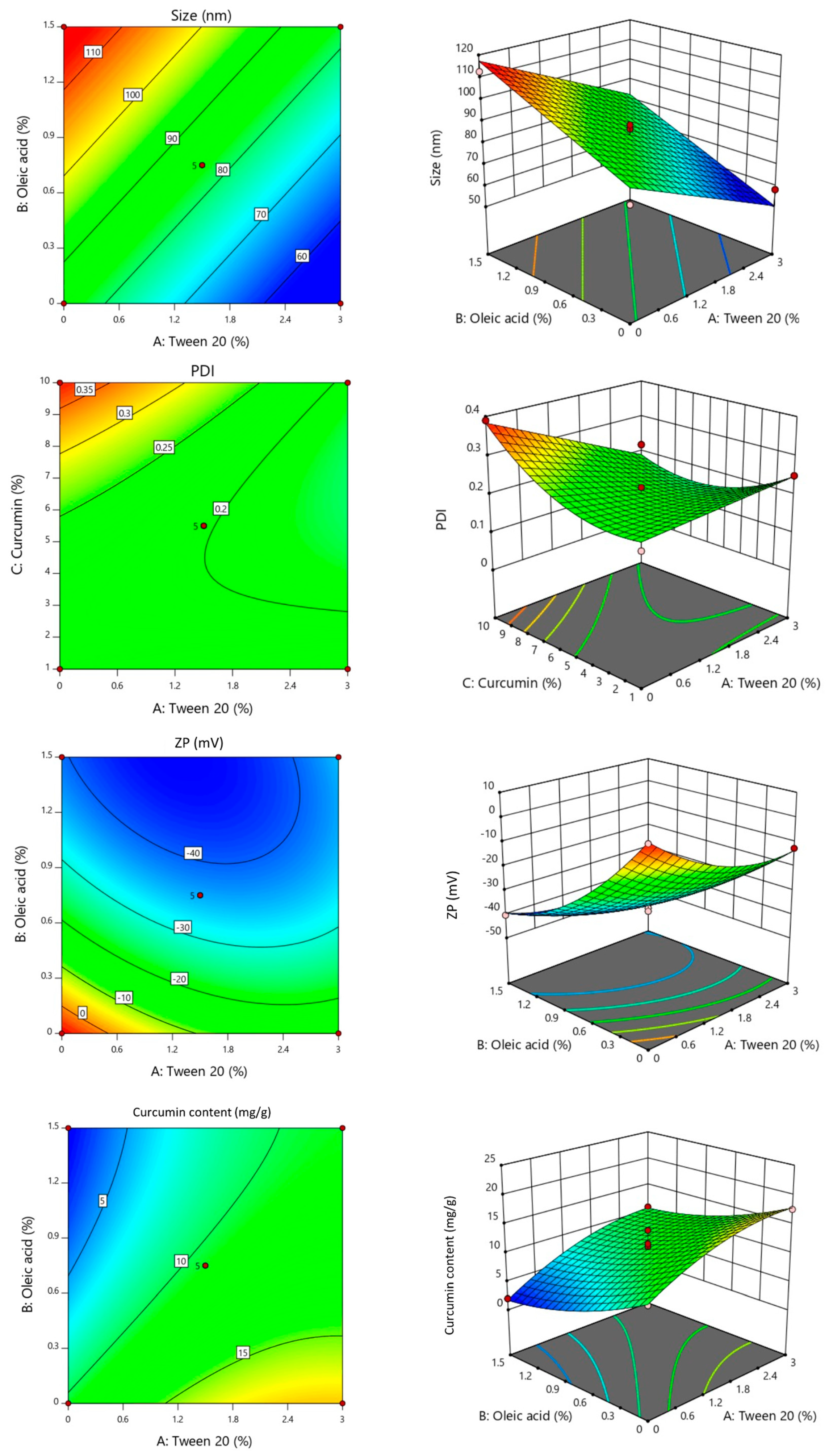

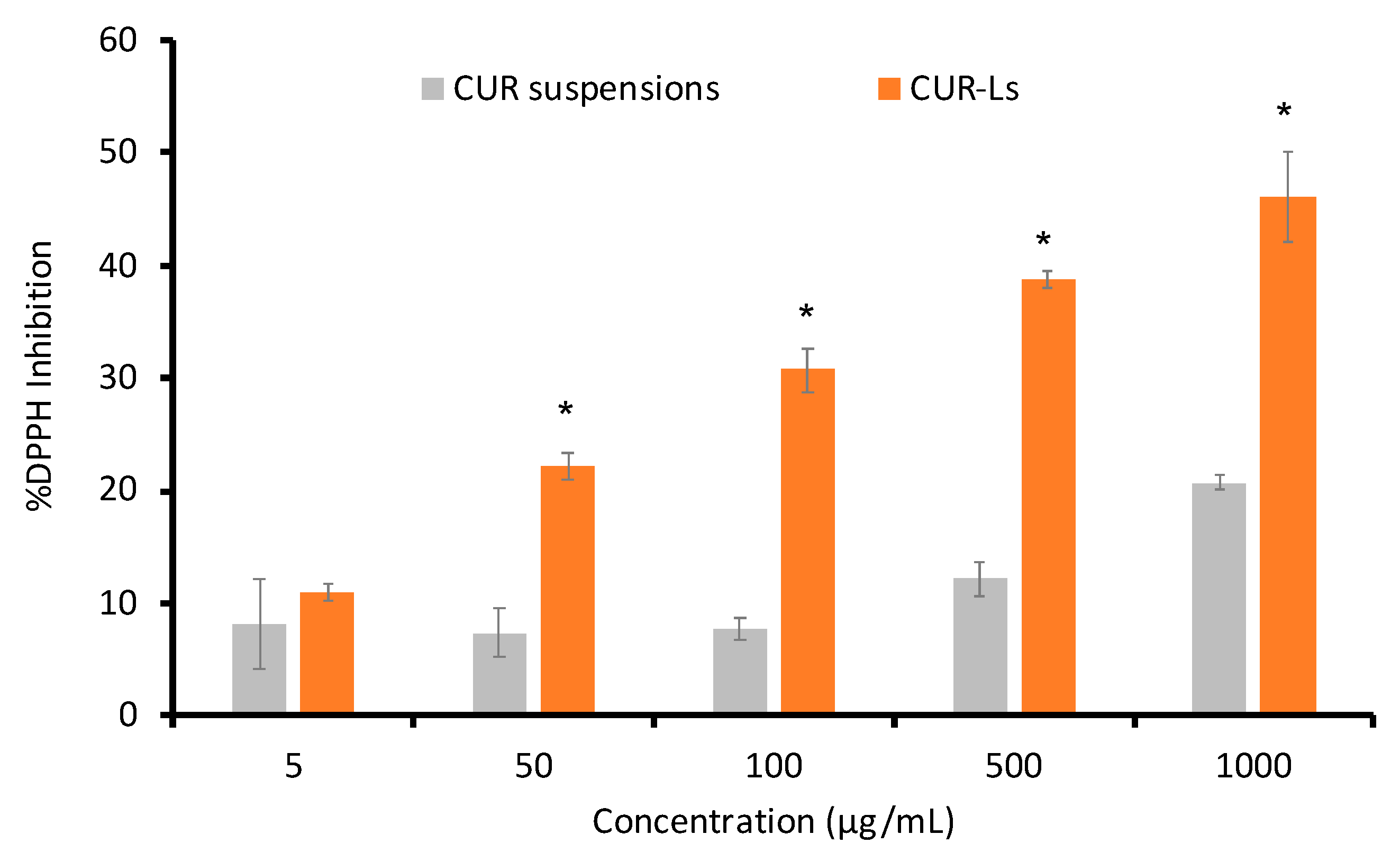
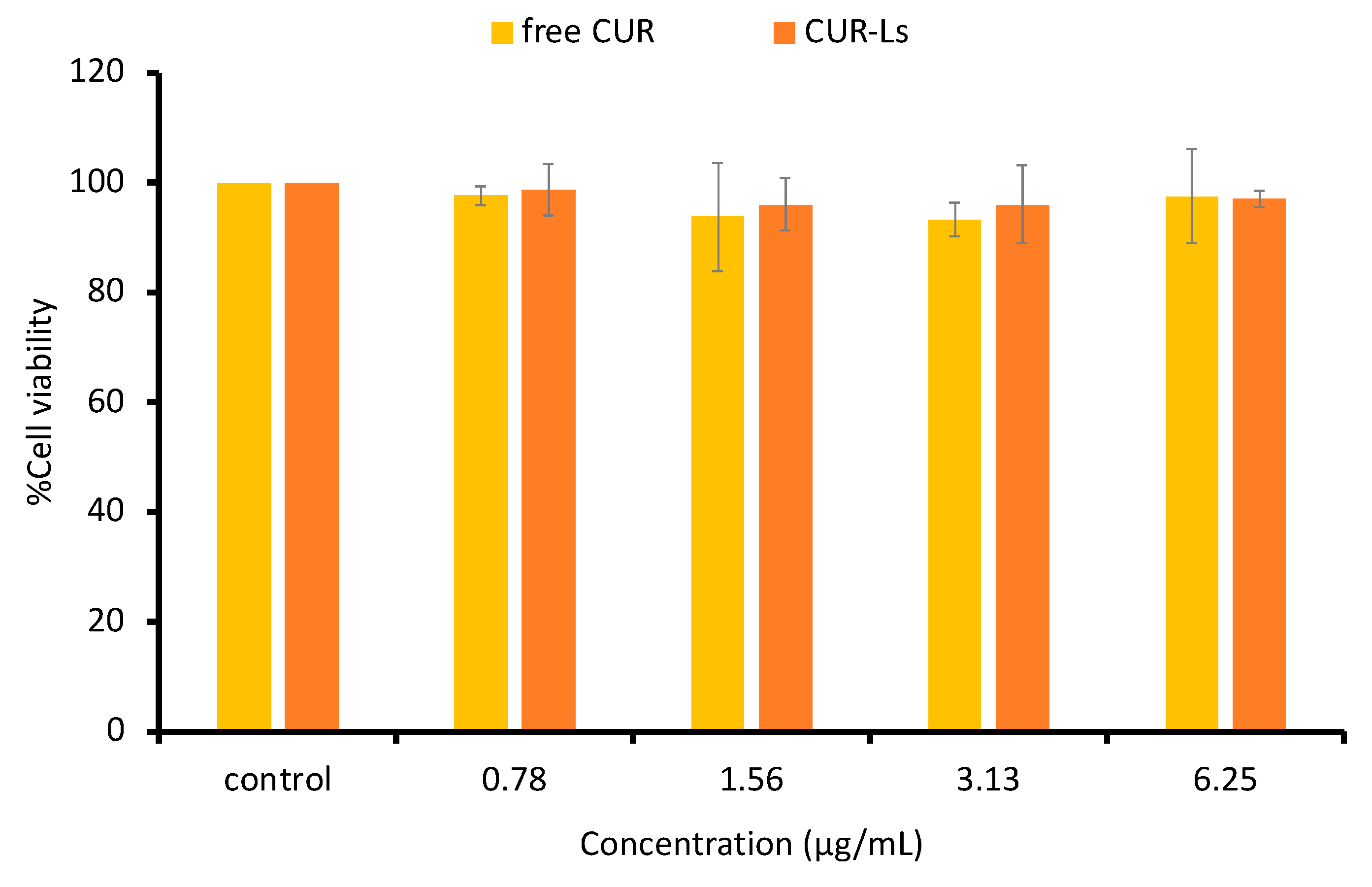
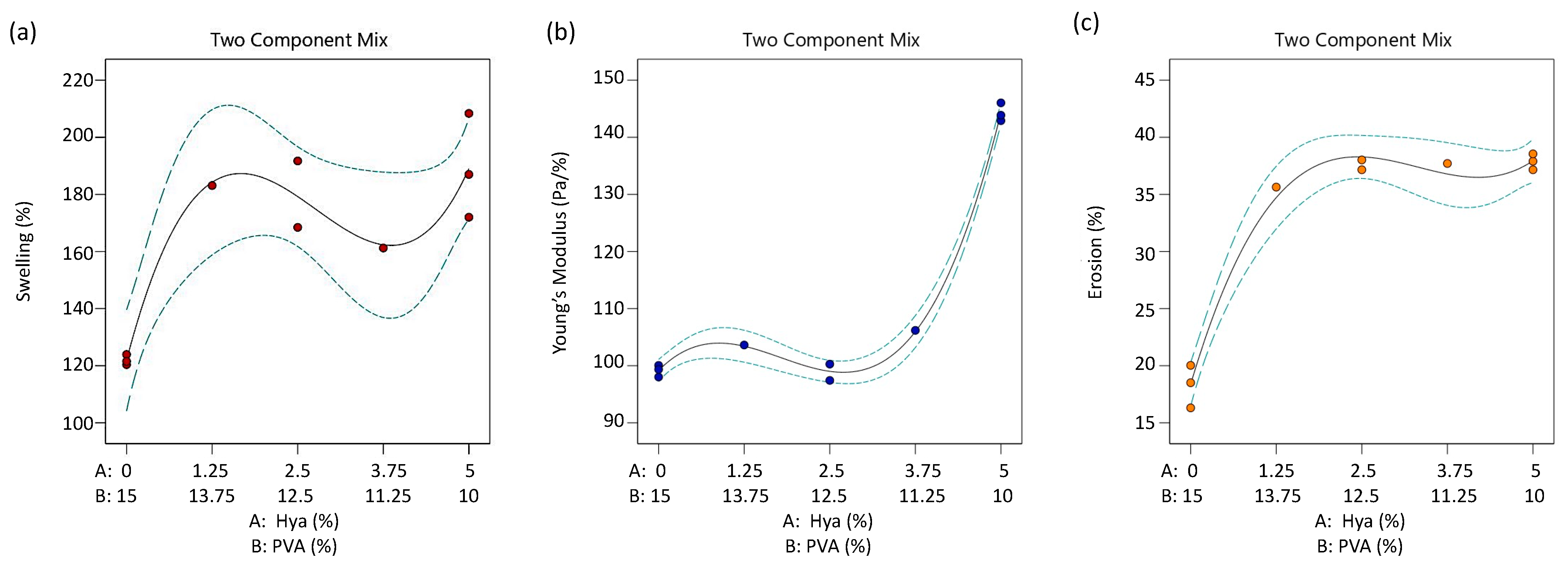

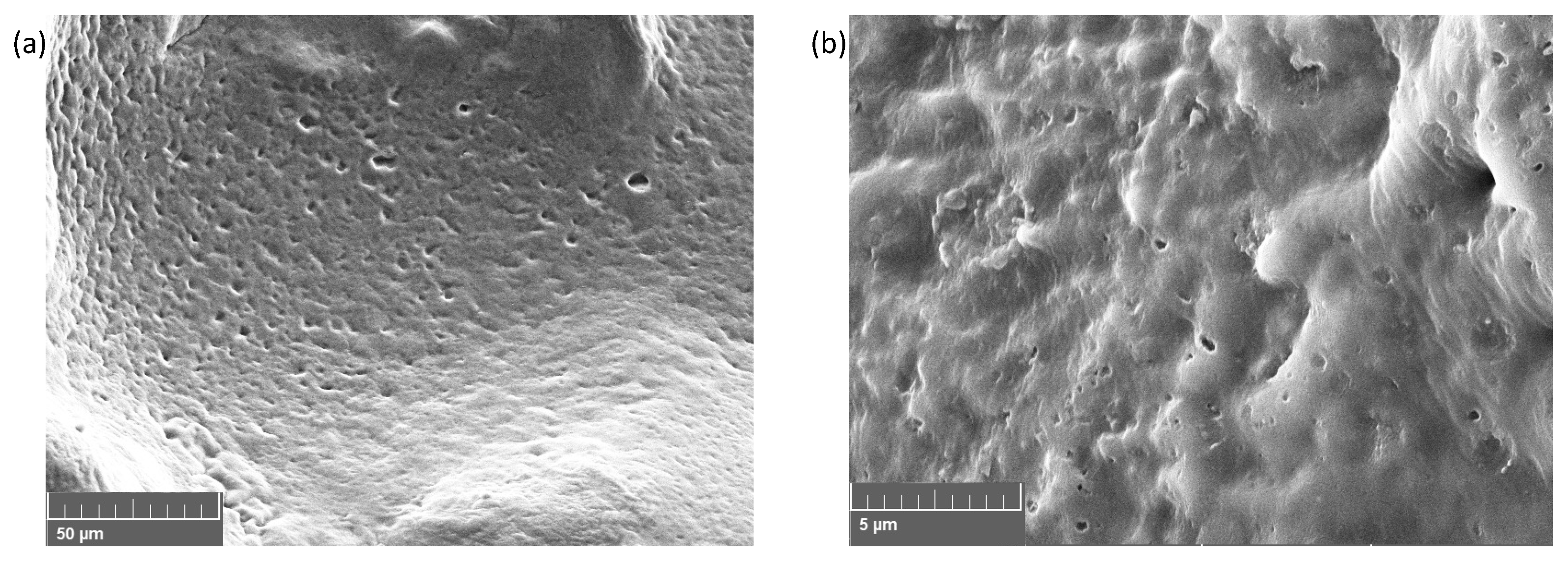

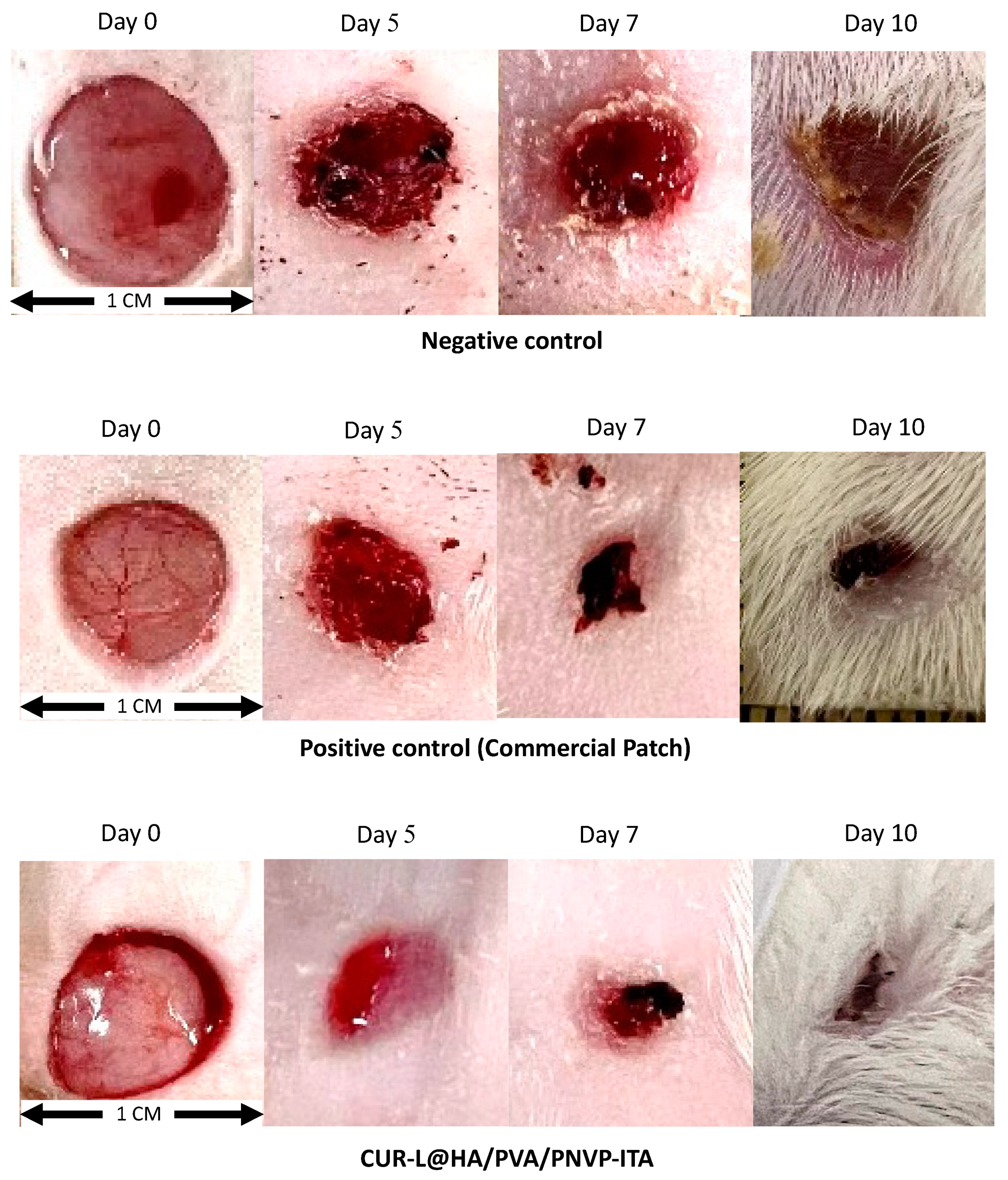
| Formulation | Input Factors (X) | Output Responses (Y) | |||||
|---|---|---|---|---|---|---|---|
| X1: Tween® 20 (%) | X2: Oleic Acid (%) | X3: CUR (%) | Y1: Size (nm) | Y2: PDI | Y3: ZP (mV) | Y4: CUR Content (µg/mg) | |
| L1 | 1.5 | 0.75 | 5.5 | 86.61 | 0.2 | −35.7 | 6.6 |
| L2 | 0 | 0.75 | 10 | 114.1 | 0.39 | −17.9 | 1.9 |
| L3 | 1.5 | 0.75 | 5.5 | 87.2 | 0.18 | −37.3 | 11.2 |
| L4 | 3 | 1.5 | 5.5 | 80.2 | 0.14 | −34.7 | 10.8 |
| L5 | 0 | 0 | 5.5 | 78.1 | 0.15 | 7.3 | 10.4 |
| L6 | 0 | 0.75 | 1 | 96.9 | 0.2 | −25.3 | 2.1 |
| L7 | 1.5 | 1.5 | 1 | 99.5 | 0.16 | −45 | 3.5 |
| L8 | 1.5 | 1.5 | 10 | 110 | 0.17 | −39.7 | 7.2 |
| L9 | 3 | 0 | 5.5 | 58.2 | 0.01 | −12.4 | 17.6 |
| L10 | 3 | 0.75 | 1 | 63 | 0.25 | −30.5 | 3.4 |
| L11 | 1.5 | 0.75 | 5.5 | 75.1 | 0.2 | −35.7 | 14 |
| L12 | 1.5 | 0.75 | 5.5 | 88.6 | 0.2 | −38.6 | 11.7 |
| L13 | 1.5 | 0.75 | 5.5 | 76.7 | 0.22 | −34 | 10.1 |
| L14 | 3 | 0.75 | 10 | 61.2 | 0.22 | −32.4 | 17 |
| L15 | 1.5 | 0 | 1 | 64.4 | 0.17 | −9.2 | 5.9 |
| L16 | 1.5 | 0 | 10 | 73.2 | 0.21 | −7.57 | 21.8 |
| L17 | 0 | 1.5 | 5.5 | 112.6 | 0.21 | −40.3 | 2 |
| Responses | Model | p-Value | Lack of Fit | R2 |
|---|---|---|---|---|
| Particle size | Linear | <0.0001 | 0.5558 | 0.8750 |
| PDI | Quadratic | 0.0093 | 0.0106 | 0.7161 |
| Zeta potential | Quadratic | <0.0001 | 0.6991 | 0.9885 |
| CUR content | Linear | 0.0012 | 0.2322 | 0.6240 |
| Multiple regression equation model (coded equation) | ||||
| Y1 = 83.86 − 17.39X1 + 16.05X2 + 4.34X3 Y2 = 0.2032 − 0.0413X1 + 0.0175X2 + 0.0262X3 − 0.0550X1X3 − 0.0796X22 + 0.0579X32 Y3 = −36.26 − 4.23X1 − 17.23X2 + 1.55X3 + 6.32X1X2 − 2.32X1X3 + 0.9175X2X3 + 7.54X12 − 8.70X22 + 2.20X32 Y4 = 10.72 + 4.05X1 − 4.03X2 + 4.12X3 | ||||
| Variables | Goal | Solution | Desirability | Confirmation | p-Value |
|---|---|---|---|---|---|
| Tween® 20 | in range | 2.718 | 1.000 | ||
| Oleic acid | in range | 0.041 | |||
| CUR | in range | 8.116 | |||
| Size | minimize | 55.80 ± 6.35 | 64.02 ± 3.37 | 0.1187 | |
| PDI | none | 0.082 ± 0.003 | 0.107 ± 0.026 | 0.2262 | |
| Zeta potential | in range | −15.03 ± 1.56 | −17.26 ± 3.56 | 0.1979 | |
| CUR content | maximize | 22.09 ± 2.22 | 19.92 ± 0.54 | 0.1758 |
| Formulation | Input Factors (A) | Output Responses (R) | |||
|---|---|---|---|---|---|
| A1: HA (%) | A2: PVA (%) | R1: Swelling (%) | R2: Young’s Modulus (Pa/%) | R3: Erosion (%) | |
| H1 | 2.5 | 12.5 | 168.45 | 97.43 | 38.02 |
| H2 | 2.5 | 12.5 | 191.72 | 100.28 | 37.16 |
| H3 | 5 | 10 | 208.37 | 146.03 | 38.55 |
| H4 | 0 | 15 | 123.93 | 100.06 | 20.03 |
| H5 | 0 | 15 | 120.39 | 98.02 | 16.31 |
| H6 | 5 | 10 | 172.02 | 143.87 | 37.16 |
| H7 | 1.25 | 13.75 | 213.11 | 103.63 | 35.64 |
| H8 | 3.75 | 11.25 | 161.23 | 106.19 | 37.71 |
| H9 | 5 | 10 | 187.00 | 142.91 | 37.90 |
| H10 | 0 | 15 | 121.55 | 99.35 | 18.51 |
| Responses | Model | p-Value | Lack of Fit | R2 |
|---|---|---|---|---|
| %Swelling | Cubic | 0.0241 | 0.8901 | 0.8424 |
| Young’s modulus | Cubic | <0.0001 | 0.8076 | 0.9957 |
| %Erosion | Cubic | 0.0083 | 0.2588 | 0.9788 |
| Multiple regression equation model (coded equation) | ||||
| %Swelling = 189.03A1 + 121.86A2 + 95.18A1A2 − 295.83A1A2 (A1 − A2) Young’s modulus = 144.29A1 + 99.16A2 − 90.84A1A2 − 106.25A1A2(A1 − A2) %Erosion = 37.95A1 + 18.36A2 + 40.52A1A2 − 41.18A1A2(A1 − A2) | ||||
| Variables | Goal | Solution | Desirability | Confirmation | p-Value |
|---|---|---|---|---|---|
| HA | in range | 5 | 0.41 | ||
| PVA | in range | 10 | |||
| Swelling | maximize | 177.9 ± 12.6 | 176.2 ± 12.0 | 0.8731 | |
| Young’s modulus | maximize | 133.6 ± 14 | 131.0 ± 18.0 | 0.8297 | |
| Erosion | minimize | 38.3 ± 1.4 | 38.3 ± 1.8 | 0.9850 |
| Kinetic Model | Parameter | CUR Suspensions | CUR-Ls | CUR-L @HA/PVA/PNVP-ITA Hydrogels |
|---|---|---|---|---|
| Zero-order | R2 | 0.8595 | 0.7688 | 0.8682 |
| MSC | 1.6768 | 1.1787 | 1.2668 | |
| Equation | F = 0.02t | F = 0.053t | F = 0.099t | |
| First-order | R2 | 0.8610 | 0.7908 | 0.9139 |
| MSC | 1.6876 | 1.2789 | 0.9367 | |
| Equation | ) | ) | ||
| Higuchi | R2 | 0.8762 | 0.9280 | 0.9186 |
| MSC | 1.8035 | 2.1456 | 0.1710 | |
| Equation | ||||
| Krosmeyer-Peppas | R2 | 0.8219 | 0.9649 | 0.9850 |
| MSC | 1.8019 | 1.9199 | 2.3622 | |
| Equation | F = 0.162tn−1 | F = 0.957tn−1 | F = 12.191tn−1 | |
| n | 0.668 | 0.538 | 0.232 |
| Day 0 | Day 3 | Day 5 | Day 7 | Day 10 | |
|---|---|---|---|---|---|
| Negative control | 0.0 ± 0.0 | 30.8 ± 4.2 | 46.2 ± 4.1 | 53.8 ± 5.6 | 65.1 ± 5.4 |
| Commercial Patch | 0.0 ± 0.0 | 27.3 ± 8.0 | 45.5 ± 3.9 | 81.8 ± 6.5 * | 84.3 ± 6.3 * |
| CUR-L@HA/PVA/PNVP-ITA | 0.0 ± 0.0 | 25.0 ± 5.0 | 66.0 ± 5.6 *,# | 88.3 ± 2.1 * | 95.2 ± 2.1 *,# |
Disclaimer/Publisher’s Note: The statements, opinions and data contained in all publications are solely those of the individual author(s) and contributor(s) and not of MDPI and/or the editor(s). MDPI and/or the editor(s) disclaim responsibility for any injury to people or property resulting from any ideas, methods, instructions or products referred to in the content. |
© 2024 by the authors. Licensee MDPI, Basel, Switzerland. This article is an open access article distributed under the terms and conditions of the Creative Commons Attribution (CC BY) license (https://creativecommons.org/licenses/by/4.0/).
Share and Cite
Pornpitchanarong, C.; Aye, K.C.; Arunprasert, K.; Opanasopit, P.; Patrojanasophon, P. Computational Designed and Optimized Liposomal Curcumin-Embedded Bifunctional Cross-Linked Hydrogels for Wound Healing. Gels 2024, 10, 598. https://doi.org/10.3390/gels10090598
Pornpitchanarong C, Aye KC, Arunprasert K, Opanasopit P, Patrojanasophon P. Computational Designed and Optimized Liposomal Curcumin-Embedded Bifunctional Cross-Linked Hydrogels for Wound Healing. Gels. 2024; 10(9):598. https://doi.org/10.3390/gels10090598
Chicago/Turabian StylePornpitchanarong, Chaiyakarn, Khin Cho Aye, Kwanputtha Arunprasert, Praneet Opanasopit, and Prasopchai Patrojanasophon. 2024. "Computational Designed and Optimized Liposomal Curcumin-Embedded Bifunctional Cross-Linked Hydrogels for Wound Healing" Gels 10, no. 9: 598. https://doi.org/10.3390/gels10090598
APA StylePornpitchanarong, C., Aye, K. C., Arunprasert, K., Opanasopit, P., & Patrojanasophon, P. (2024). Computational Designed and Optimized Liposomal Curcumin-Embedded Bifunctional Cross-Linked Hydrogels for Wound Healing. Gels, 10(9), 598. https://doi.org/10.3390/gels10090598






